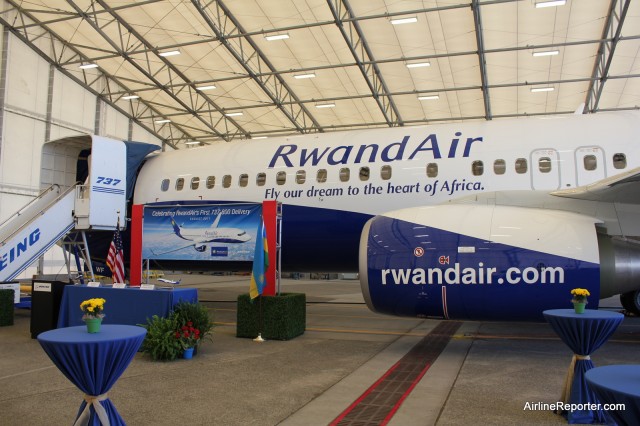
RwandAir's first Boeing 737-800 sits in a hangar at Boeing Field.
What does a Boeing 737 mean to you? For most, it is a common airliner found around the world. For many airlines, it is an reliable revenue-making machine. However, for others it is more than just the sum of its parts. For RwandAir and the country of Rwanda it represents progress and national pride that no one can put a price tag on.
Rwanda is a country with a troubled past (I will go into more about that in a future story), but they have come so far in a very short amount of time. It is a land locked country, looking to grow. To successfully do so, they need a viable air transportation infrastructure. RwandAir operations were started in 2003 to help Rwanda achieve that goal.
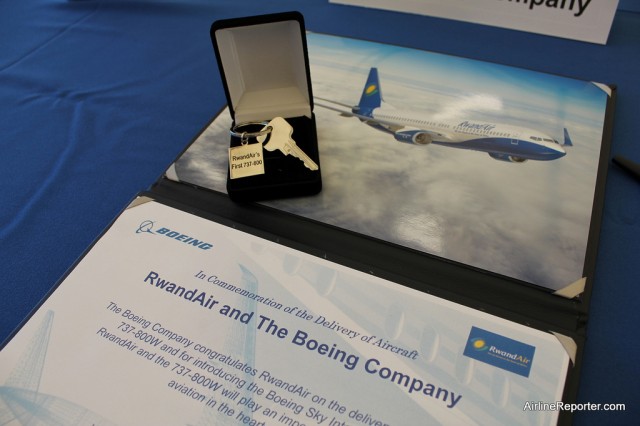
Boeing gave RwandAir keys to the plane. No, they are not needed to start the plane.
RwandAir recently took delivery of their first new airliner ever: a Boeing 737-800 with Sky Interior. I was invited to tag along for the delivery and the flight of the aircraft from Seattle (SEA) to Kigali, Rwanda (KGL). I was able to stay a few days in Rwanda and learne more about the culture, the people and the drive to grow as a nation. I will share these experiences in a multi-part series from the pre-delivery dinner to my experiences in Rwanda.
How does an airline get a plane made to only fly about 3,000 miles from Seattle to Rwanda? I did not know, but I surely wanted to find out. The adventure started with a special dinner held at the Museum of Flight under an SR-71. It did not take long for me to realize that this was not only about getting a new airplane, but it was about celebrating the progress that Rwanda as a country has made.
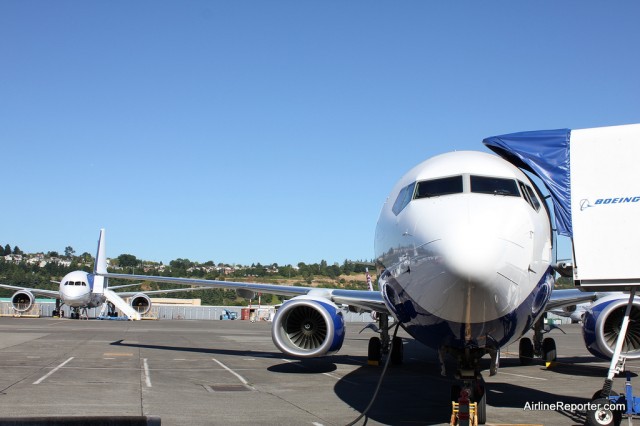
Before leaving, the 737-800 was pulled in front of a 787 Dreamliner.
During his passionate speech during dinner, the CEO of RwandAir, John Mirenge, stated that he knows “what aviation can do to change lives and nations.” Mirenge hopes to continue to build his airline with additional aircraft (including the Boeing 787 Dreamliner) and vows to come back to Seattle, “We will be regular visitors in this town. It is a dream come true.” As previously reported, RwandAir hopes to reach 12 aircraft in the next five years and to 18 aircraft by 2020. The dinner eventually wound down and people prepared for the long flight starting the next day.
Originally, the delivery flight was supposed to take off at 11am on Thursday August 23rd. There were two delays that happened, but since we were only a group of about 30 and we had no formal plans, it did not matter too much. The first delay of 2pm was because the airline wanted to install their in-flight entertainment software, which takes three hours and they cannot start the process until the money is exchanged. However, there were some computer issues and a power blackout at the bank, which resulted in a delay in transferring the money. Luckily it finally came through, but the flight ended up being delayed an additional 3.5 hours to about 5:30pm.
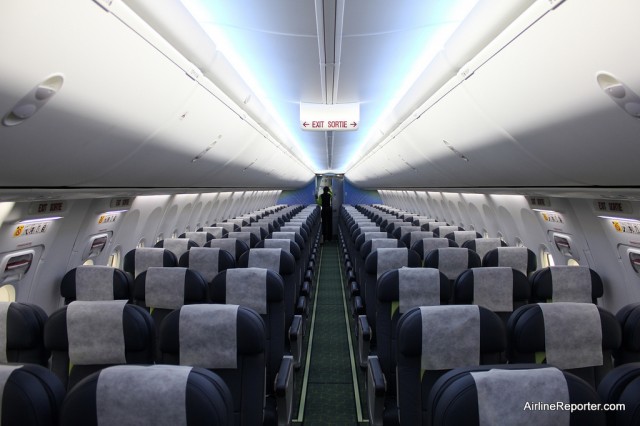
The new Boeing Sky Interior is pretty slick, especially for a flight which will take about 20 hours.
This was okay since Boeing had RwandAir’s 737 in a hangar with food, drinks and music, giving us an opportunity to check out the aircraft. After we realized how long the delay was going to be, Boeing got a shuttle van and drove everyone to a local bar to have some drinks. It was quite awesome to have the CEO of RwandAir serve you a beer.
We were not there too long before we got the word it was time to go. We all piled back into the shuttle bus and headed back to the Delivery Center. Before being able to board the aircraft, everyone has to go through security, just like you would at the airport, but these security guards seemed nicer than those found in airports. While we were enjoying our beer, Boeing had the 737 towed right in front of the delivery center. After a few more photos, it was time to get on board to start our adventure.
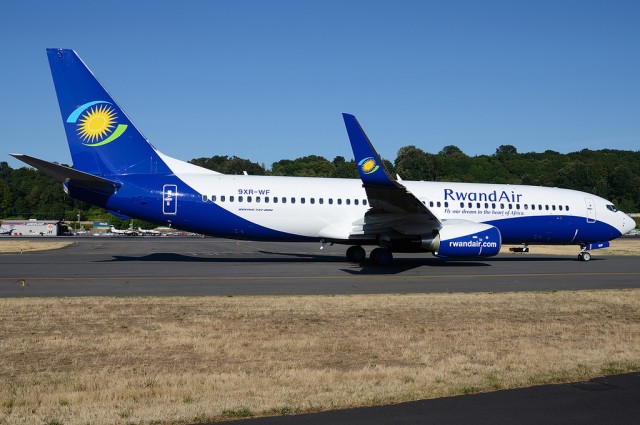
Our flight taxiing at Boeing Field. Taken by Andrew W. Sieber.
Seats were not assigned and I had the pick of almost any row in economy. I first went straight to the exit rows, thinking I was being smart, but darn it. The armrests in those rows did not move, so they were no good. I decided on Row 14 and I took over seats A through F for me and all my stuff. Even with having an entire row, I wasn’t too sure if I would remain comfortable during an almost 20 hour flight.
I could feel the excitement and enthusiasm on the aircraft as we were pushed back to taxi out. As we moved down the taxi way, I could see Boeing 787 Dreamliners and 747-8’s out the windows — that never gets old. We taxied to the end of the runway and took off quite quickly due to the light load. We were off on our big adventure — next stop Iceland, then a night in Istanbul before arriving in Kigali, Rwanda to a cheering (and dancing) crowd.
RWANDAIR BOEING 737-700 DELIVERY FLIGHT
Part 1 | Part 2 | Part 3 | Video | 737 Photos | Rwanda Photos | Destination Story | All
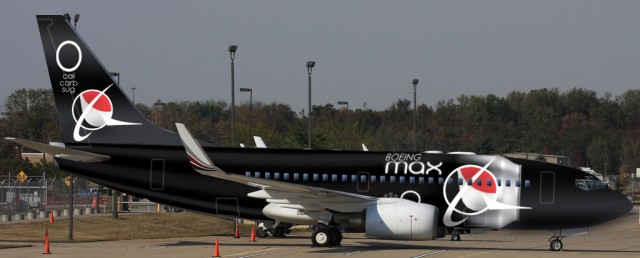
Is this the new Boeing 737 MAX livery? Nope, but a great Photoshop by Lyle Jansma.
There are two stories with the unveiling of the new Boeing 737 MAX: the actual aircraft (which promises greater efficiency) and the choice of the name “MAX.” When I heard about Boeing’s name for their 737 re-engine, for some odd reason, I got really thirsty and wanted a Pepsi… weird. While this story should lead with the differences of the new 737, I feel I have to talk about the new name first, since it is the most shocking.
Boeing is a smart company that makes respected aircraft. They have a history of creating legendary names: Stratocruiser, Stratoliner, and of course Dreamliner. The name “MAX” is just not in the same category in my opinion — it seems lazy and very “been there, done that.”
There has been a lot of speculation on what Boeing might call their 737 Re-engine: the 737RE, 737-8, 737NNG. Many people have been excited to find out the new name. Reading different reactions on the internet, it appears I am not the only one who is disappointed.
According to Boeing, these next, next generation aircraft will be written as the “737 MAX 7”, “737 MAX 8” and “737 MAX 9” without dashes. I think I might be writing them as 737-7, 737-8, 737-9 with dashes and no “MAX.”
The 737 Next Generation was a great name. I even like Airbus’ new A320neo name to describe their more efficient aircraft to compete with the 737.
Yes, I understand the ideas behind Boeing choosing this name, but it doesn’t mean the name works. During the press conference announcing the re-engined 737, Nicole Piasecki explained why Boeing chose the MAX name. “We wanted the name to capture how exceptional the 737 is not only to in terms of its performance but we wanted it to be able to differentiate the 7, 8 and 9. We wanted to make sure the name was easily identifiable from 4-year olds up to 90-year olds and we wanted to make sure that it represented the best that it will truly be… We thought about how do you convey superiority, the best, the gold standard in single-aisle airplanes. And how do you come up with a name to describe already a great airplane. We wanted to make sure that it talked about what it was going bring to the industry in terms of maximum benefit, maximum competitive advantage for our customers, maximum value and absolute maximum in what an airplane could deliver to our customers. So we came up with something that fit that and we will be calling this airplane the 737 MAX.”
With all the creative and smart people at Boeing this is the best (er max) that they could do?
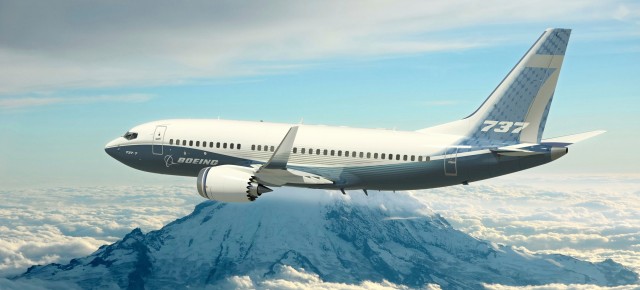
I like the new real livery of the 737 MAX, but not so sure about the name. Image from Boeing.
Will an airline not choose this aircraft because of the name? Of course not. They are going to care more about the performance and the bottom line. Going with a re-engine 737 versus a whole new product makes sense. Airlines have already showed a strong demand for an updated single-aisle aircraft sooner rather than later. Going with a re-engined 737 will allow Boeing to improve the 777 and develop additional models for the 787.
There are already496 orders for the new MAX aircraft from five airlines. Those that already have 737NG’s on order will most likely have the opportunity to change over to MAX aircraft.
Boeing states the 737 MAX will have a 16% less fuel consumption than their “competitor’s current offering” (we will assume that is the Airbus A320) and it will have 4% less than the A320neo. The new plane will use CFM International LEAP-1B engines and is expected to have its first delivery sometime in 2017.
So what are your thoughts? Do you like the 737 MAX name?
MORE:
* Video of the new 737 MAX
* Great fake press release of the new 737 MAX
Boeing 737 Pepsi MAX livery done by Lyle Jansma
This post is written by aviation and photography enthusiast Drew Vane about the MD-80:
Ahhh. I remember the good ole days when the aircraft were loud, smoked like a B-52 and fuel efficiency was unheard of. No, I’m not talking about the 60’s. I’m talking about yesterday.
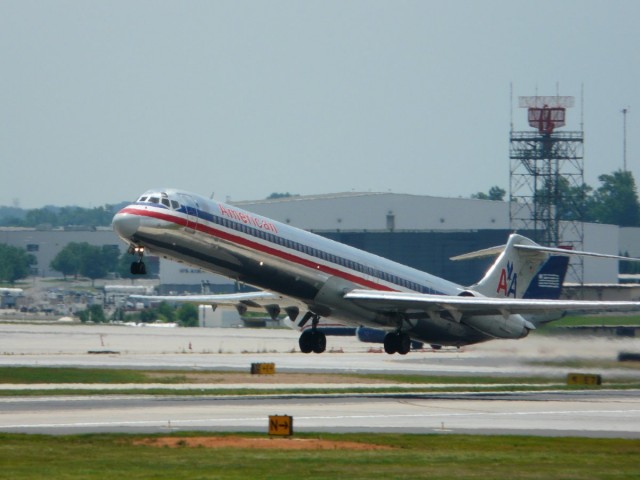
An American Airlines MD-83 (Super 80) lifts off of Runway 36C at Charlotte-Douglas International Airport.
As commercial aircraft manufacturers transitioned from props to jets, Douglas Aircraft Corporation developed a smaller jet aircraft for the shorter range domestic market. The 90seat DC-9 first flew in 1965 and gave birth to additional series, culminating with the 50-series under the original DC-9 design. McDonnell-Douglas introduced its newest, longer version of the DC-9, fondly called the DC-9 Super 80, or MD-80. This 142-seat product of Long Beach, CA got its start with PSA Airlines (eventually to become US Airways). The MD-80 added 15 feet in length and 20 feet in wingspan, resulting in an additional 28 seats to the 139-seat DC-9-50.
Similarly, the MD-80 family (also called the ’œMad Dogs’) has improved with each subsequent version. The MD-88 added aerodynamic improvements for longer range, a redesigned tail-cone, and glass cockpit. The MD-90 upgrade increased capacity to 150 passengers and replaced the Pratt & Whitney JT8D engines with quieter, more fuel efficient IAE V2500 engines. Following the merger of McDonnell-Douglas with Boeing in 1997, a further upgrade, the MD-95, was born which eventually became the 117 seat Boeing 717. The 717 added a more advanced cockpit, more efficient engines, fly-by wire controls, and other features to bring it into the 90’s and beyond. Strangely, the AFC (or Advanced Common Flightdeck) most closely resembles that of the massive MD-11. Over 2,400 DC-9 series aircraft have been produced over the last 40 years.
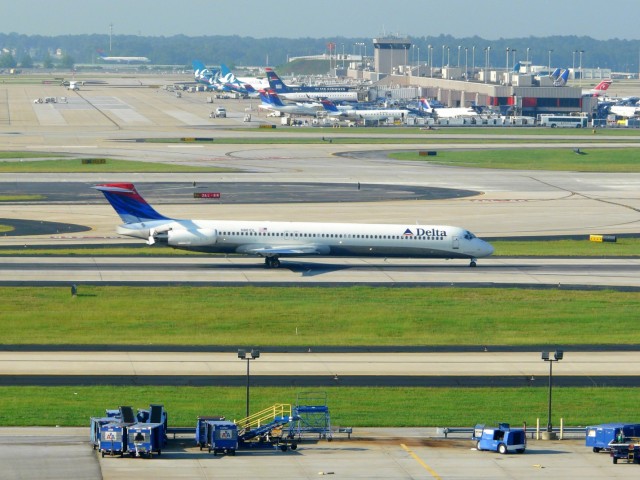
Look Ma! No Rabies! A Delta Air lines MD-88 slows after landing at Atlanta’s Hartsfield International Airport
Although the seating configuration is a bit skewed (2-3), today you’ll still find these workhorses on domestic routes for Delta, American and Allegiant here in the US. The Boeing 717 is flown in the US by AirTran (soon to be Southwest) and Hawaiian Airlines. As of midway through 2010, there were over 450 Mad Dogs still flying here in the US with 100 or so still active in other countries.
Its been a long time since my last Mad Dog flight but I was pleasantly surprised last November when I flew with my family on an AirTran Boeing 717 down to Florida. The holidays brought free WiFi and the aircraft just felt newer compared to my memories of the Mad Dogs. Here in Charlotte, there are ample opportunities to spot the Airtran 717’s and Delta MD-88’s bound for Atlanta as well as the fully loaded American Super-80 bound for Fort Worth that seems to use every inch of the runway on taking off.
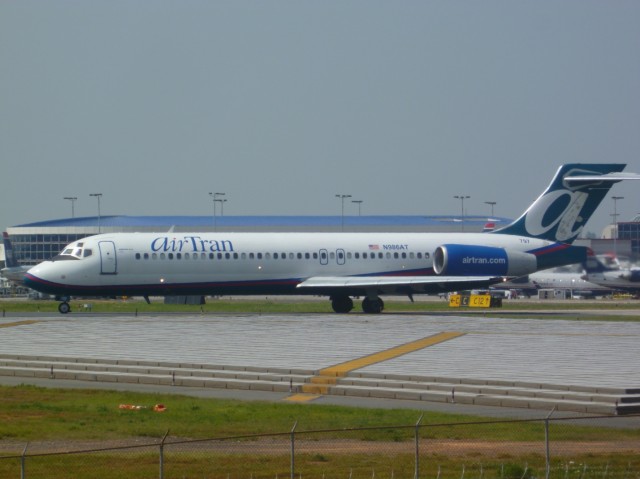
Mad Dog Wannabe: An AirTran Boeing 717 taxis onto Runway 18L at Charlotte Douglas International Airport.
Unfortunately, the sun is slowly setting on these older aircraft as more eco-friendly, and efficient domestic jets continue to enter the market. American recently announced its plan to replace its fleet of MD-83’s (in addition to its 757’s and 767’s) with re-engined Boeing 737 and Airbus A320neo jets and its expected that Delta will follow in its footsteps to stay competitive. Have you had the opportunity to ride on these gas guzzlers lately? I’d love to hear about your experience.
More info on the background of the MD-80 here and MD-90 here.
All photos by Andrew Vane
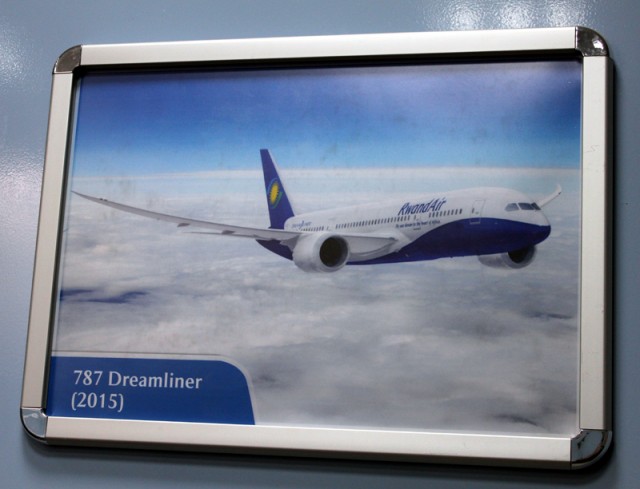
At RwandAir's headquarters at Kigali Airport, they have mutliple images of a Boeing 787 Dreamliner in their livery around the office. This mock up shows a hopeful operation date of 2015.
I have been learning a lot about Rwanda and RwandAir over the past few days and will be sharing everything over the next week or so. I wanted to give a quick update on RwandAir’s aircraft and route planning, since it is quite surprising and involves a few Boeing 787 Dreamliners.
The airline has just taken delivery of their first new aircraft ever, a Boeing 737-800 with Sky Interior. According to RwandAir CEO John Mirenge this is just the beginning. He stated that they hope to increase their current fleet of six aircraft to 12 over the next five years and up to 18 by 2020. Currently they operate a fleet of two Boeing 737-500s, one Boeing 737-800 (a second one coming in October), two CRJ-200s and one Dash 8. By 2020, they hope to take delivery of additional Boeing 737s, ATR-72, Embraer regional jets and Boeing 787 Dreamliners — new.
Mirenge told AirlineReporter.com that he hopes to fly the Dreamliners to China, Europe and possibly the eastcoast of the United States. The airline hopes to create a hub of air transportation in Kigali, providing the demand for the larger aircraft.
It seems that flying the Dreamliner by 2015 might be a bit optimistic. It might be difficult to get a delivery slot by then and Kigali is in the process of building a new airport to better handle the expected increase of traffic, but is not set to be completed until 2018.
It is unusual for an airline to be so candid about their future plans of aircraft purchases and future routes. However, RwandAir is a different sort of airline and definitely have created a positive momentum.
Who wouldn’t want to spend a beautiful and sunny Saturday at Paine Field with a bunch of historic aircraft and other aviation enthusiasts? Well, I am hoping for the sun, but I am pretty sure of the good times. This Saturday, the Vintage Aircraft Weekend will be going down at Paine Field and if you are in the greater Seattle are, you should surely come check it out. From vintage aircraft (that fly) to vehicles to historians, this is going to be one awesome shin-dig. Here are the details:
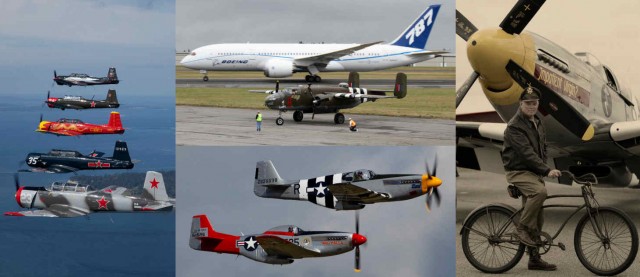
Just some of the things spotted during Vintage Aircraft Weekend 2010.
What: An opportunity to experience history in action at a family event. Enjoy vintage aircraft flybys, military and antique vehicles, hands-on demonstrations, WW II re-enactors, interactive presentations, great food, live swing/jazz music, dancing, and special activities to commemorate the Centennial of Naval Aviation. As many as 50 aircraft will be on display and most will fly on the afternoon of the 3rd.
When: Friday, September 2, 2011, 6:00 pm to 10:00 pm (Big Band Dinner Dance) and Saturday, September 3, 2011, 9:00 am to 5:00 pm (Festival)
Where: Historic Flight Foundation Restoration Center
Located on the southwest corner of Paine Field
10719 Bernie Webber Drive
Mukilteo, Washington 98275
Speakers: Addison Pemberton and William E. Boeing, Jr. will address the importance of the Model 40B to the survival of the Boeing Company during the Great Depression. Dan Hagedorn will present “Hiding in Plane Site,” the story of operating Boeing Plant 2 in wartime camouflage. Mike Lavelle will share “Lessons Learned 100 Years Ago in the 1911 Transcontinental Flight of the Vin Fiz.” John Sessions will present two hundred shots taken in 2009 during the North Atlantic crossing of B-25D “Grumpy.”
Why: Educate and inspire visitors of all ages through an opportunity to experience history in action!
Tickets: Tickets for the Big Band Dinner Dance on the 2nd are $50 per person and include admission to the festival on the 3rd.
Discounted tickets for the festival on the 3rd may be purchased in advance for $10 at Historic Flight Foundation or online. Tickets for the festival on the 3rd may also be purchased at the door on the day of the event: Adults – $12 | Senior/Military – $10 (65+) | Youth – $8 (6-15) | Child – Free (< 6) | Family – $25
Who: Hosted by Historic Flight Foundation along with many supporters including Cascade Warbirds, Castle & Cooke Aviation, Flying Heritage Collection, Future of Flight, Heritage Flight Museum, Museum of Flight, Paine Field, Port Townsend Aero Museum, and media sponsor – KUOW.
All photos from Air Vintage Weekend website for 2010











